This creamy cauliflower soup is a classic of French cuisine named after Countess Dubarry, King Louis XV’s mistress.
What is a Du Barry dish?
Whenever you see the term Du Barry or Dubarry for a French dish, know that the recipe includes cauliflower.
This soup is very quick and easy to make at home. It’s also very healthy as it just contains vegetables and a bit of milk. Creamy with no cream.
Crème Du Barry is also often served on winter menus, from the small brasserie at the corner of Parisian streets to chic restaurants.
How to prepare Crème Du Barry
Crème Du Barry is a well-blended soup made with mainly cauliflower.
The principle is to pre-cook the cauliflower florets (steamed or boiled). Then finish cooking cauliflower
- with onions (shallots for me, leek whites is another possibility) that were sautéed but not browned in butter. It’s crucial not to color onion / shallot / leek because you want the soup to be as white as Madame Du Barry’s porcelain-like white and voluptuous skin.
- in a mix of broth and milk. You may use poultry broth or vegetable broth for a vegetarian version. Note that we don’t use any cream; milk and cauliflower blended together will give a smooth, creamy texture.
You may also cook in stock only, adding cream at the end. Not traditional but it works well.
Toppings
Garnish with freshly ground pepper and chopped fresh herbs (chives, parsley…).
According to Auguste Escoffier in his Guide Culinaire, the classic garnish is to add tiny cauliflower florets (pre-cooked in boiling water à l’anglaise as we say in French cuisine, lit. English-style ) and some chervil.
Eventually, according to your taste (this is not the classic way of serving it), dress with croutons (why not gingerbread croutons as I do for my pumpkin soup), a dash of olive oil, a spoon of crème fraîche, or some cauliflower florets sautéed in a pan with butter and maybe some spices.
If so, when pre-cooking the cauliflower, add extra for garnish.
And why not try gastronomic variations of this soup with the addition of foie gras, truffle peelings, and quickly sautéed scallop…
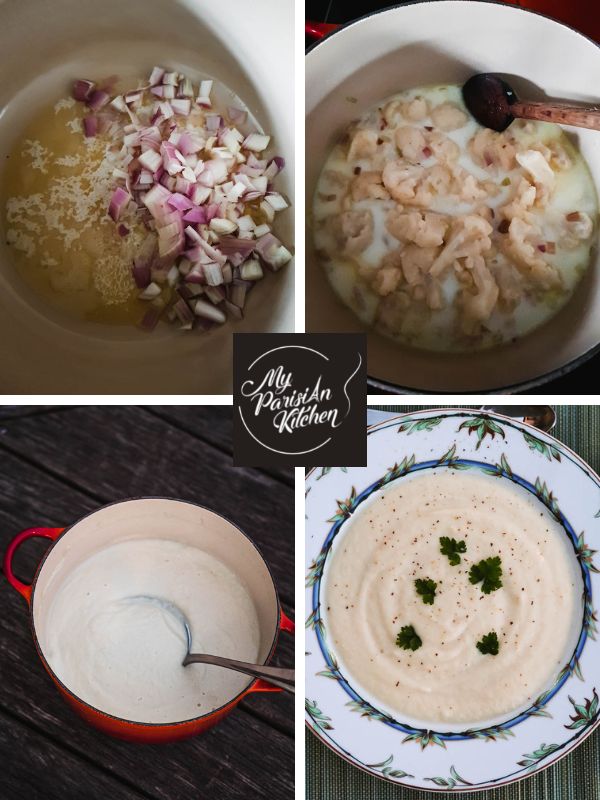
Difference between crème Du Barry and velouté Du Barry
If we want to be accurate and stick to the tradition, there is a slight difference between crème and velouté Du Barry.
- Velouté in French cuisine refers to a smooth well blended soup. However, here velouté Du Barry does not refer to the fact that soup is mixed. Egg yolks are added having a binding. I confess I wasn’t tested yet.
- Crème Du Barry refers to the soup with no egg yolks added, just mixed with hand mixer or blender.
How to write Du Barry?
Shall we write in one word Dubarry or in two words Du Barry. And with 2 capital letters?
- Du is either a capital letter or not: Du Barry or du Barry. In France de or du does not have a capital lettre when it’s an aristocratic particule.
- I rely on the choice of the Château de Versailles castle with 2 capital letters: Du Barry.
- Some write Dubarry in one word, but b this is a mistake, as Madame Du Barry’s name was in two words.
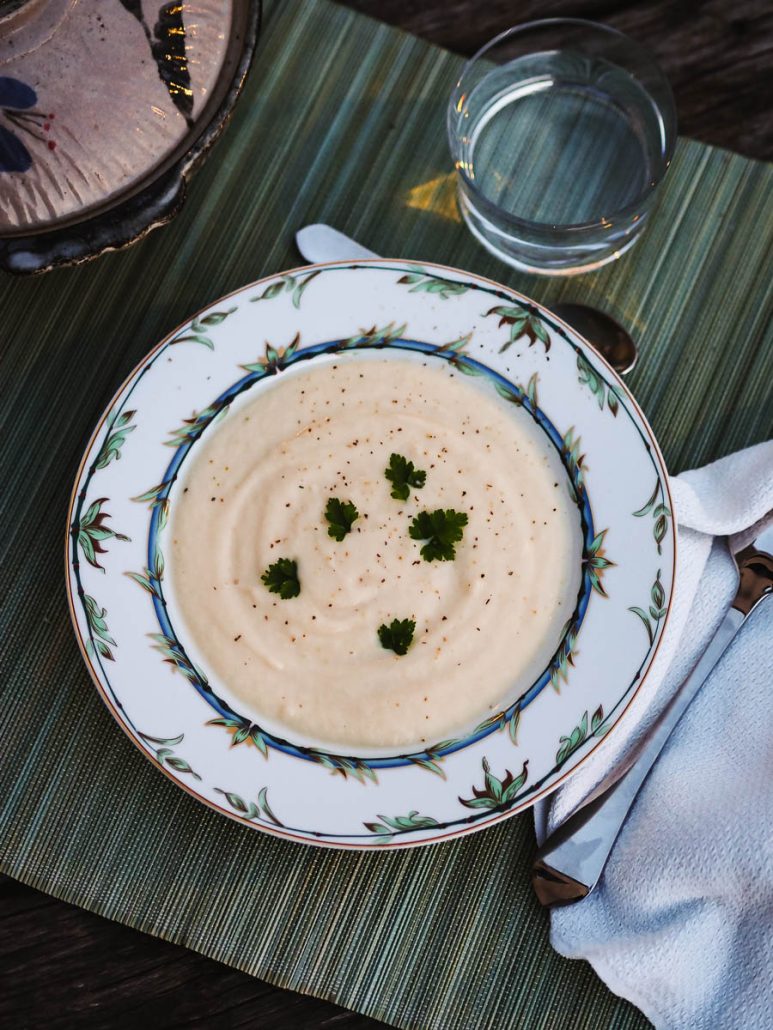
Origin and story of Crème Du Barry
The name of this soup, Du Barry refers to the Countess Du Barry (1743-1793), French King Louis XV’s mistress. She was his last mistress after the Marquise de Pompadour, who died in 1764.
It is said that Louis XV was madly in love with her. The royal romance lasted for 5 years until the King’s death in May 1774.
Jeanne Bécu was her real name (also known as “Mademoiselle Vaubernier”). She wasn’t born in a noble family, not a countess from birth but after her wedding, but the daughter of a seamstress and a bawdy monk.
She grew up in a relatively poor family. She began life as a hairdresser’s apprentice and store girl before moving up in society, collecting lovers and meeting Count Jean Du Barry. She gained the Countess title after marrying him.
When she met Louis XV, she was only 25. The already elderly King was immediately seduced by her great beauty and her sharp-mindedness. It is said that she considered him as a man, not a King.
Louis XV made her his official mistress and installed the Countess Du Barry in one of the apartments at the Château de Versailles in 1768.
The Countess Du Barry hired a great cook named Mauconseil to please the King, who was a great gourmet.
It was customary at the time to name a new dish after the royal mistress.
This is the reason why a number of dishes were named after Madame la Comtesse Du Barry: “à la Du Barry” (lit. the Du Barry way) all based on cauliflower, a vegetable she loved.
A la Du Barry or simply the name of the dish + Du Barry (in France we call this recipe crème Du Barry without even mentioning that there is cauliflower in, it’s obvious).
The first recipe that comes to mind is the classic soup crème Du Barry I’m sharing here.
An example of an old dish was cauliflower à la Du Barry: cauliflower and pommes château potatoes topped with Mornay sauce (iMornay is a béchamel sauce with egg yolk and cheese) and baked au gratin.
Chou-Fleur – Cauliflower in French cuisine
Cauliflower was introduced to France by Louis XIV’s gardener, Jean-Baptiste de La Quintinie, creator of the Versailles kitchen garden. He brought it up to date by convincing the royal kitchens of its gustatory qualities.
From the original Italian name Cavalofiore, it quickly became known as “Coliflori” in French and, by analogy with the plant’s florets chou-fleur: chou means cabbage, and fleur means flower.
A few dish examples as cauliflower is frequently used in French cuisine:
- raw small florets to dig in dips at l’apéro. The French like to serve raw vegetables (carrot, cucumber, cauliflowers…).
- raw grated instead of boulgour for tabouleh
- roasted whole or cut in a pan or in the oven with spices
- in a gratin with bechamel sauce and grated cheese.
- cooked and mixed for a purée or a soup. See my way of preparing cauliflower swith blue cheese and a bit or pear. Yes pear.
- a new trend in France, male pizza crust
- There are of course many other recipes with cauliflower.
If you walk in Parisian streets, you might see shops named Comtesse Du Barry, selling gourmet tinned terrines, foie gras, truffles, ready made meals… Nothing to do with this soup.
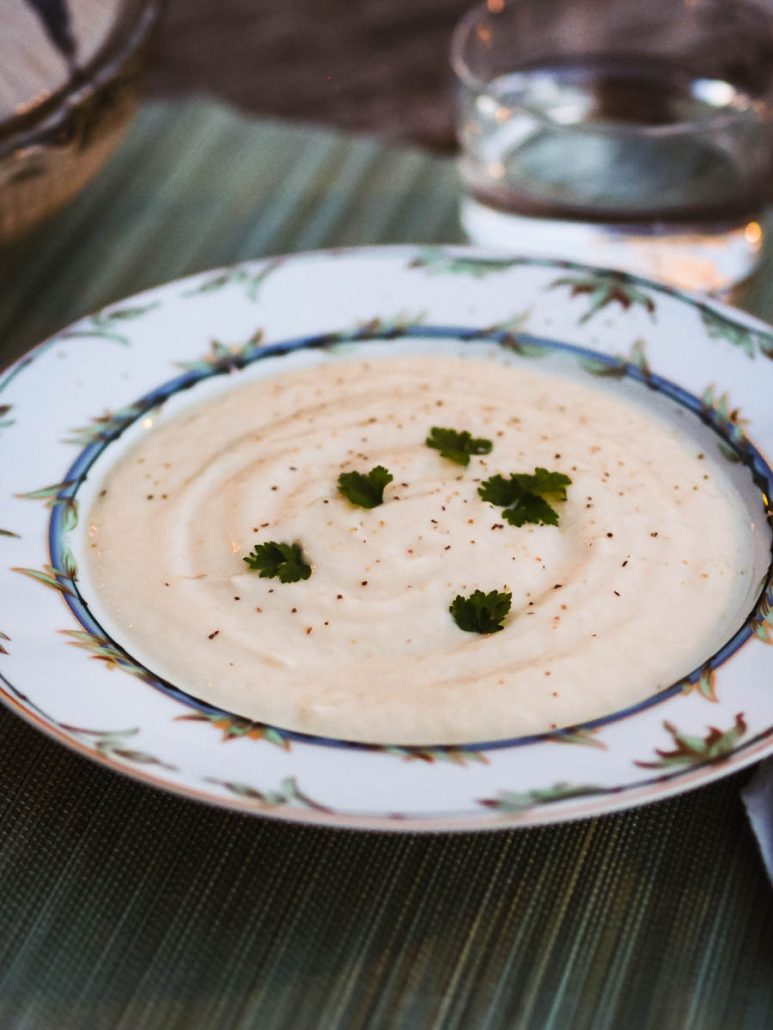
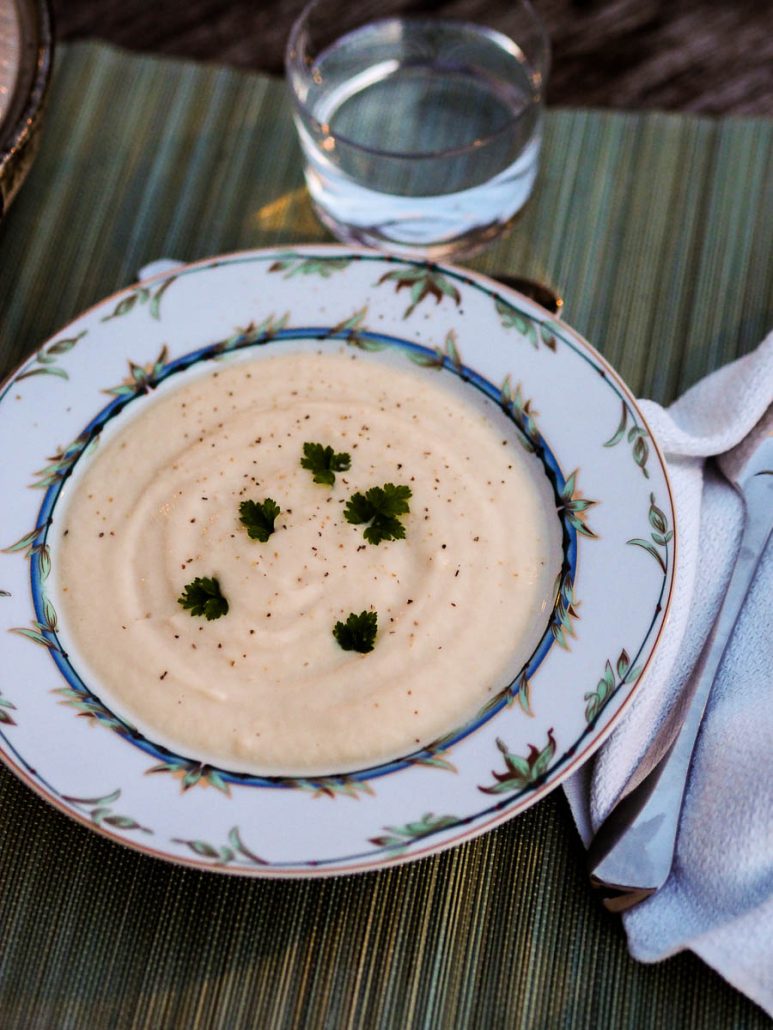
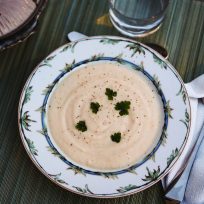
Cauliflower Dubarry Cream Soup
Ingredients
- 500 gr cauliflower 1 small cauliflower
- 2 shallots
- 40 gr butter
- 250 ml chicken broth or vegetable broth
- 250 ml milk
- salt
- pepper ideally white pepper
Instructions
Prepare cauliflower.
- Remove the leaves and cut off the florets. Rinse under water.
- Heat a large volume of water in a pan.
- Pre-cook the cauliflower in boiling water for 15 minutes. Drain. You may use a steamer instead.
Cook the soup
- Heat the butter in a casserole dish. Meanwhile, chop the shallots.
- Sauté shallots for 5 minutes (without browning; we want a white soup).
- Add the cauliflower, milk, and chicken stock. Season with salt and pepper.
- Bring to a boil, then lower the heat.
- Cook over medium heat for about ten minutes.
Blend
- Blend to get a smooth, homogeneous, and creamy texture. Taste and adjust seasoning.
Notes
The tradition of this soup is to be very white. Therefore, when sautéing shallots, make sure not to color them; otherwise, you won’t get a very white cream-like soup.
Read in the article above the recipe the entire story behind the dish and who was Madam Dubarry.
Bon appétit !
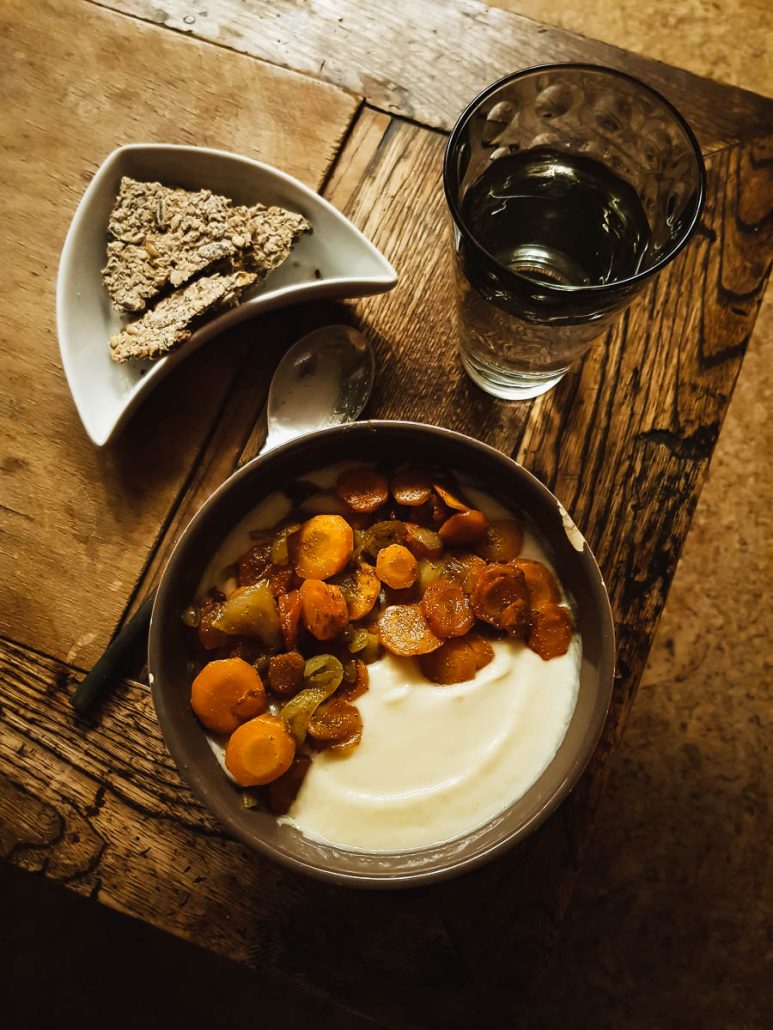
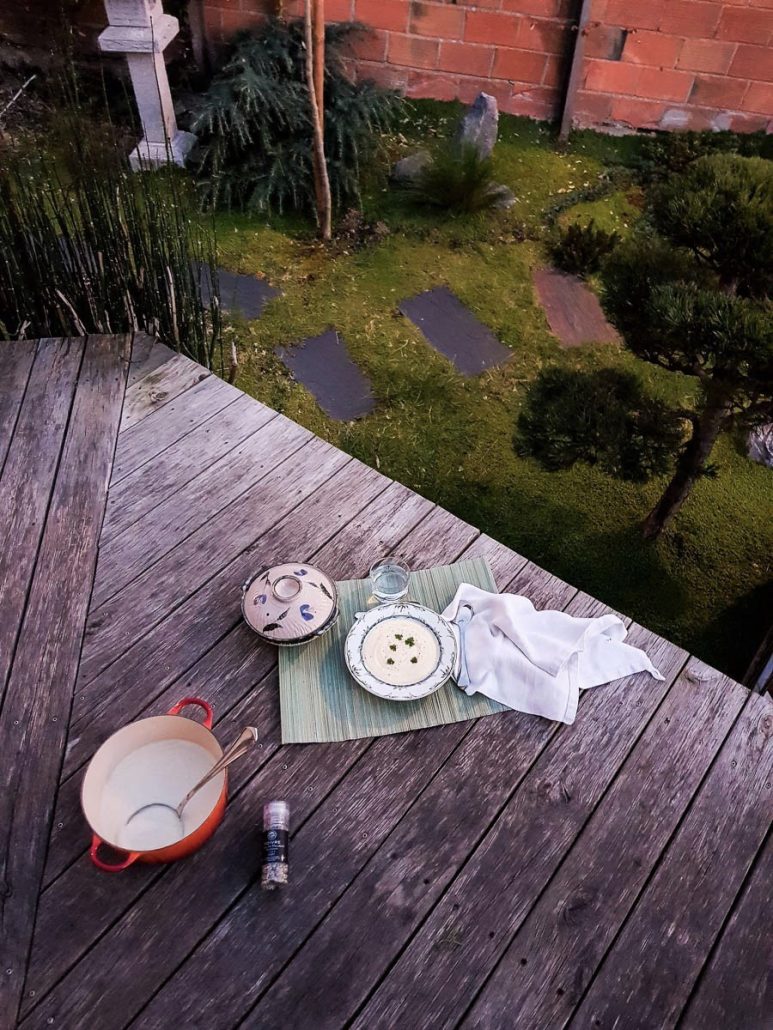
Two fun facts about my foodie journey
Not always time for food styling. All the recipes I share with you are real French home cooking: the dishes I actually make daily for my family or I prepare for dinners or parties with my relatives.
I prefer to focus on sharing authentic French cuisine that tastes good rather than making a whole fuss preparing food styling that corresponds to social media trends or food photography and styling standards.
Therefore, I’m often in a situation where the dish is terrific, but I don’t have time to make a beautiful setup (my husband is a bit fed up with eating cold!) or, as here, it’s getting too dark at dinner time to shoot with natural light.
This Du Barry soup was quickly shot on my terrace facing my tiny Japanese garden.
That’s the second fun fact: a Japanese garden in my Parisian garden! I started this blog after giving cooking lessons to Japanese expats in Paris. I lived in Japan, speak Japanese, and am in absolute love with all things nature-related, so of course, Japanese gardens. You can read my story to know more.
The second photo is my Sunday evening dish with leftovers, I enjoyed sautéed carrots with cumin and homemade crispbread with lots of seeds.
